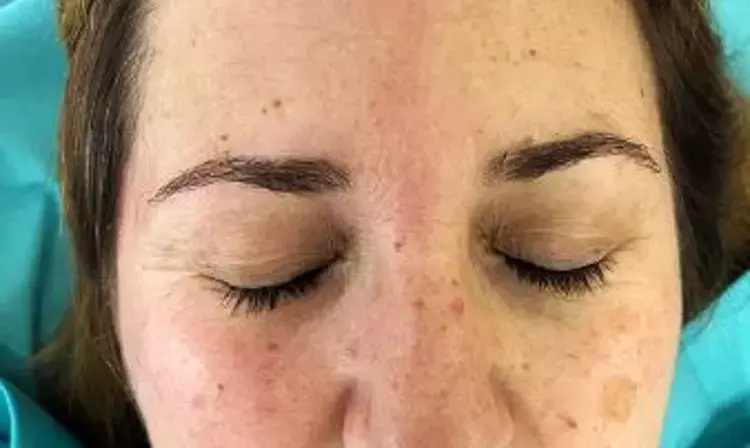- Home
- Medical news & Guidelines
- Anesthesiology
- Cardiology and CTVS
- Critical Care
- Dentistry
- Dermatology
- Diabetes and Endocrinology
- ENT
- Gastroenterology
- Medicine
- Nephrology
- Neurology
- Obstretics-Gynaecology
- Oncology
- Ophthalmology
- Orthopaedics
- Pediatrics-Neonatology
- Psychiatry
- Pulmonology
- Radiology
- Surgery
- Urology
- Laboratory Medicine
- Diet
- Nursing
- Paramedical
- Physiotherapy
- Health news
- Fact Check
- Bone Health Fact Check
- Brain Health Fact Check
- Cancer Related Fact Check
- Child Care Fact Check
- Dental and oral health fact check
- Diabetes and metabolic health fact check
- Diet and Nutrition Fact Check
- Eye and ENT Care Fact Check
- Fitness fact check
- Gut health fact check
- Heart health fact check
- Kidney health fact check
- Medical education fact check
- Men's health fact check
- Respiratory fact check
- Skin and hair care fact check
- Vaccine and Immunization fact check
- Women's health fact check
- AYUSH
- State News
- Andaman and Nicobar Islands
- Andhra Pradesh
- Arunachal Pradesh
- Assam
- Bihar
- Chandigarh
- Chattisgarh
- Dadra and Nagar Haveli
- Daman and Diu
- Delhi
- Goa
- Gujarat
- Haryana
- Himachal Pradesh
- Jammu & Kashmir
- Jharkhand
- Karnataka
- Kerala
- Ladakh
- Lakshadweep
- Madhya Pradesh
- Maharashtra
- Manipur
- Meghalaya
- Mizoram
- Nagaland
- Odisha
- Puducherry
- Punjab
- Rajasthan
- Sikkim
- Tamil Nadu
- Telangana
- Tripura
- Uttar Pradesh
- Uttrakhand
- West Bengal
- Medical Education
- Industry
Oxybutynin and propranolol combo successfully resolves symptoms in Harlequin syndrome: Case report

Source- Naharro-Fernández C, de Quintana-Sancho A, López-Sundh AE, Reguero-Del Cura L, Gónzalez-López MA. Successful treatment of idiopathic Harlequin Syndrome with oxybutynin and propranolol. Australas J Dermatol. 2021 Nov;62(4):504-505. doi: 10.1111/ajd.13665. Epub 2021 Jul 27. PMID: 34314021.a
Oxybutynin and propranolol combination successful in Harlequin syndrome- 1st case report- Harlequin syndrome (HS) is a rare disorder characterised by unilateral facial flushing and sweating induced by exercise, heat and emotion. It is mostly idiopathic. In some cases, it can lead to social embarrassment. It is difficult to treat and can have a significant impact on quality of life.
Recently a case describing successful treatment of idiopathic HS with a combined therapy of oxybutynin and propranolol was published in Australasian Journal of Dermatology.
A 47-year-old woman presented with hyperhidrosis and erythema episodes limited to the right side of the face, triggered by physical exercise. She was receiving prophylactic metoprolol with suboptimal control of her migraine episodes. Magnetic resonance imaging of brain and cervical spine and chest radiograph were normal. Treatment with oxybutynin (5 mg/daily orally) resulted in optimal control of hyperhidrosis but facial flushing persisted so she was switched over from metoprolol to propranolol (10 mg/8 h orally). The patient experienced a marked improvement in frequency, intensity and duration of the facial flushing, and better control of her migraine episodes.
Treatment of HS has been unsatisfactory with medical line of treatment and contralateral sympathectomy is reserved for severe cases. Oxybutynin is the most commonly used anticholinergic drug in hyperhidrosis. The frequent adverse effects of this drug are xerostomia, mydriasis, cycloplegia, urinary retention, tachycardia and palpitations which should be kept in mind before prescribing this drug.
Scientific evidence regarding the control of flushing symptoms in HS is scarce. Activation of beta-2 receptors located in the vessels may play a role in the flushing phenomena observed in HS patients. These receptors are antagonised by nonselective beta blocker, inducing vasoconstriction and minimising the resulting erythema thus explaining improvement with switching over from metoprolol to propranolol. Propranolol should not be prescribed to patients with heart failure or asthma. No interactions between oxybutynin and propranolol have been documented.
To conclude this is the first report of a patient with idiopathic HS successfully treated with oxybutynin and propranolol in whom both hyperhidrosis and facial erythema resolved. Thus the combination of oxybutynin and propranolol should be considered in patients with HS not having any contraindications to these medications.
Source- Naharro-Fernández C, de Quintana-Sancho A, López-Sundh AE, Reguero-Del Cura L, Gónzalez-López MA. Successful treatment of idiopathic Harlequin Syndrome with oxybutynin and propranolol. Australas J Dermatol. 2021 Nov;62(4):504-505. doi: 10.1111/ajd.13665. Epub 2021 Jul 27. PMID: 34314021.a
MBBS
Dr Manoj Kumar Nayak has completed his M.B.B.S. from the prestigious institute Bangalore medical college and research institute, Bengaluru. He completed his M.D. Dermatology from AIIMS Rishikesh. He is actively involved in the field of dermatology with special interests in vitiligo, immunobullous disorders, psoriasis and procedural dermatology. His continued interest in academics and recent developments serves as an inspiration to work with medical dialogues.He can be contacted at editorial@medicaldialogues.in.
Dr Kamal Kant Kohli-MBBS, DTCD- a chest specialist with more than 30 years of practice and a flair for writing clinical articles, Dr Kamal Kant Kohli joined Medical Dialogues as a Chief Editor of Medical News. Besides writing articles, as an editor, he proofreads and verifies all the medical content published on Medical Dialogues including those coming from journals, studies,medical conferences,guidelines etc. Email: drkohli@medicaldialogues.in. Contact no. 011-43720751


